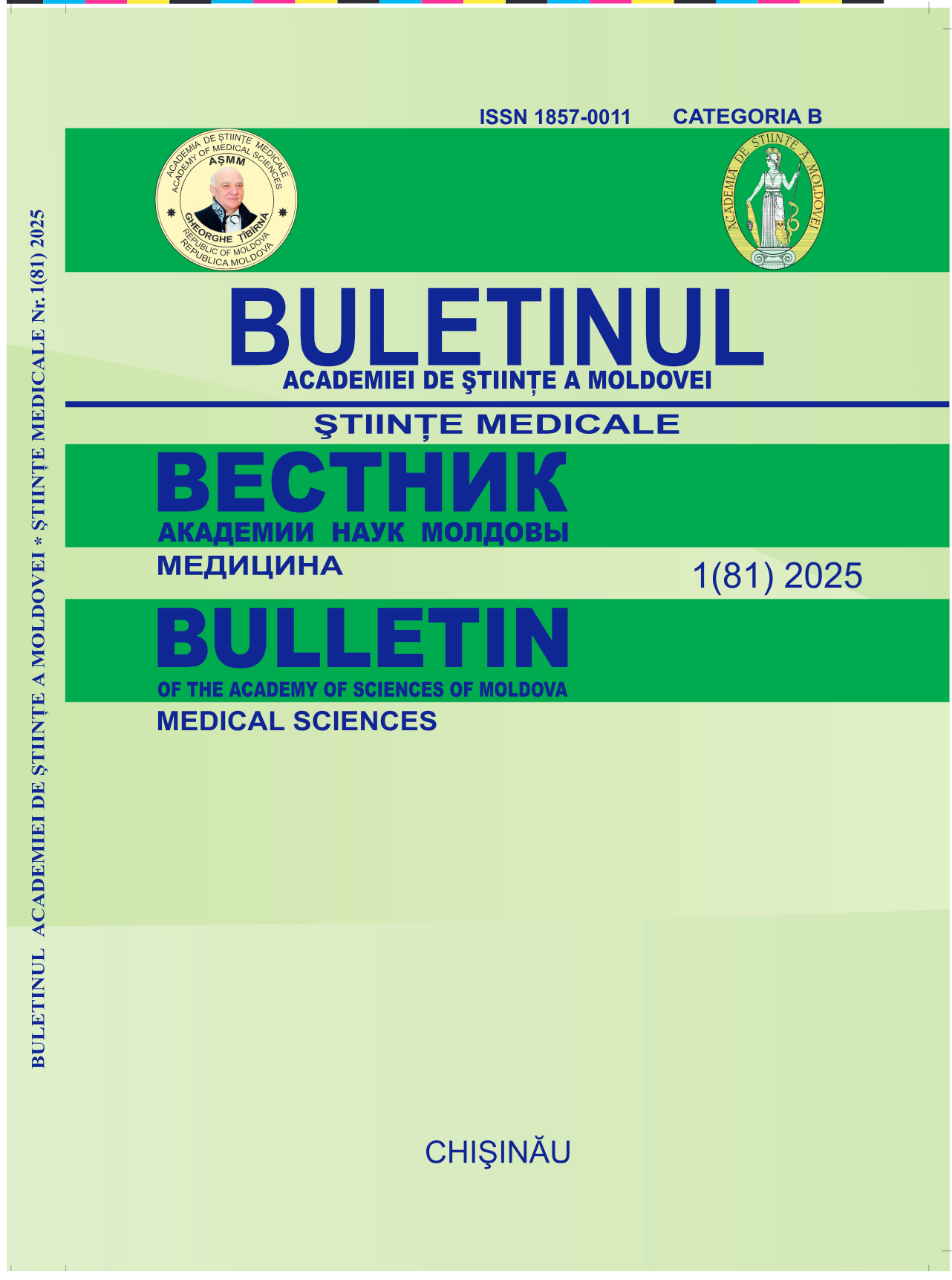Clinico - functional particularities of deceased patients with STEMI and NSTEMI 12 months after revascularization
DOI:
https://doi.org/10.52692/1857-0011.2025.1-81.04Keywords:
STEMI, NSTEMI, 1-year mortality, risk factors, cardiogenic shock, ejection fractionAbstract
Introduction: Acute myocardial infarction remains a leading cause of cardiovascular mortality worldwide [1 ]. However, ST-elevation MI (STEMI) and non-ST-elevation MI (NSTEMI) patients differ in clinical profile - STEMIs often cause greater acute myocardial damage, whereas NSTEMIs tend to occur in older patients with more comorbidities [1]. These differences may impact 12-month outcomes. Aim: To compare the clinical and functional characteristics of patients who died within 12 months after revascularized STEMI versus NSTEMI, identifying factors associated with 1-year mortality. Methods: We performed a retrospective observational study of 1,078 revascularized MI patients (528 STEMI, 550 NSTEMI) followed for one year. We identified 176 patients who died within 12 months (95 STEMI and 81 NSTEMI) and analyzed their baseline risk factors, clinical presentation (including Killip class), laboratory findings, echocardiographic parameters (left ventricular ejection fraction - LVEF), and comorbidities. Results: The two groups of deceased patients were similar in age (~70 years). Both had very high prevalence of hypertension (>90%) and a low proportion of active smokers (~12%). NSTEMI decedents more often had diabetes (~55% vs 44%) and hypercholesterolemia (~79% vs 57%) than STEMI decedents. NSTEMI decedents also had more frequently a history of prior MI (~50% vs ~36%), stroke (23% vs 12%), or peripheral arterial disease (16% vs 8%). By contrast, cardiogenic shock at presentation was more common in STEMI decedents (Killip class IV in 27% vs 16%). Severe left ventricular dysfunction (LVEF <30%) was present in about half of the patients in both groups. Acute atrial fibrillation occurred more often in STEMI (30% vs 18%). Conclusions: Within 12 months post-infarction, patients dying after STEMI had more severe acute presentations (more cardiogenic shock and arrhythmias), whereas those dying after NSTEMI had a higher burden of risk factors and comorbidities. Nonetheless, both cohorts exhibited significant left ventricular dysfunction and high complication rates, indicating that both the acute infarct severity and underlying chronic conditions contribute to 1-year mortality after MI.
References
Chang, S. S., et al. Prognosis Between ST-Elevation and Non-ST-Elevation Myocardial Infarction in Older Adult Patients. Frontiers in Cardiovascular Medicine, 2022, vol. 8, article 749072, https://doi.org/10.3389/fcvm.2021.749072.
Bouisset, F., et al. Comparison of Short- and Long-Term Prognosis between ST-Elevation and Non-ST-Elevation Myocardial Infarction. Journal of Clinical Medicine, 2021;10(2):180. https://doi.org/10.3390/jcm10020180.
Nguyen, T. M., et al. Mortality in Patients with Acute Coronary Syndrome–A Prospective 5-Year Follow-Up Study. Journal of Clinical Medicine, 2023;12(20):6598. https://doi.org/10.3390/jcm12206598.
Bouisset, Frédéric, et al. Type 2 Diabetes Mellitus in Acute Myocardial Infarction: A Persistent Significant Burden on Long-Term Mortality. Frontiers in Cardiovascular Medicine, 2024;11:1401569.
Tien, Yu-Tzu, et al. The CSP (Cardiogenic Shock Prognosis) Score: A Tool for Risk Stratification of Cardiogenic Shock. Frontiers in Cardiovascular Medicine, 2022;9:842056.
Sterling, L., et al. Long-Term Outcomes of Cardiogenic Shock Complicating Myocardial Infarction. Journal of the American College of Cardiology, 2023;82(10):985–995.
Saczynski, J. S., et al. Trends in Atrial Fibrillation Complicating Acute Myocardial Infarction. American Journal of Cardiology, 2009;104(2):169–174. https://doi.org/10.1016/j.amjcard.2009.03.011.
Anzai, Toshihisa, et al. C-Reactive Protein as a Predictor of Infarct Expansion and Cardiac Rupture after a First Q-Wave Acute Myocardial Infarction. Circulation, 1997;96(3):778–784.
Perelshtein Brezinov, Olga, et al. Prognostic Value of Ejection Fraction in Patients Admitted with Acute Coronary Syndrome: A Real World Study. Medicine, 2017;96(9): e6226. https://doi.org/10.1097/MD.0000000000006226.
Dagres, Nikolaos, and Gerhard Hindricks. Risk Stratification after Myocardial Infarction: Is Left Ventricular Ejection Fraction Enough to Prevent Sudden Cardiac Death? European Heart Journal, 2013;34(26):1964–1971. https://doi.org/10.1093/eurheartj/eht109.
Crenshaw, Brian S., et al. Atrial Fibrillation in the Setting of Acute Myocardial Infarction: The GUSTO-I Experience. Journal of the American College of Cardiology, 1997;30(2): 406–413.
Kinjo, Kunihiro, et al. Impact of High-Sensitivity C-Reactive Protein on Predicting Long-Term Mortality of Acute Myocardial Infarction. The American Journal of Cardiology, 2003;91(8):931–935.
Takeji, Yasuaki, et al. Differences in Mortality and Causes of Death between STEMI and NSTEMI in the Early and Late Phases after Acute Myocardial Infarction. PLOS ONE, 2021;16(11):e0259268.
Nguyen, T. M., et al. Mortality in Patients with Acute Coronary Syndrome–A Prospective 5-Year Follow-Up Study. Journal of Clinical Medicine, 2023;12:6598. https://doi.org/10.3390/jcm12206598.
Downloads
Published
License
Copyright (c) 2025 Bulletin of the Academy of Sciences of Moldova. Medical Sciences

This work is licensed under a Creative Commons Attribution 4.0 International License.



